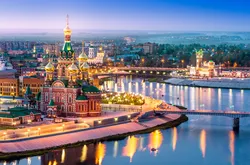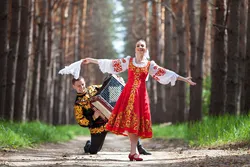See all articles relating to: Russia

Russia, officially known as the Russian Federation, is the largest country in the world, covering an area of 17.1 million square kilometers. The earliest known state on Russian territory was the Kievan Rus, which emerged in the 9th century and reached its peak in the 11th century. During the 16th and 17th centuries, Russia underwent a period of expansion, annexing territories and building a powerful empire. The reign of Peter the Great in the late 17th and early 18th centuries marked a turning point in Russia's history, as he modernized the country and brought it closer to Europe. Later, the Russian Revolution of 1917 led to the overthrow of the Tsarist autocracy and the establishment of the Soviet Union, which lasted until its collapse in 1991. Notable figures in Russia's history include Ivan the Terrible, Peter the Great, and Catherine the Great, who played significant roles in shaping the country's political, social, and cultural landscapeץ
Research your ancestors on MyHeritage
The regions of RussiaThe regions of Russia
Russia is divided into 85 federal subjects, which include 22 republics, 9 krais (territories), 46 oblasts (provinces), 3 federal cities (Moscow, Saint Petersburg, and Sevastopol), 1 autonomous oblast, and 4 autonomous okrugs:
Republics:
- Republic of Adygea
- Republic of Altai
- Republic of Bashkortostan
- Republic of Buryatia
- Republic of Crimea
- Republic of Dagestan
- Republic of Ingushetia
- Kabardino-Balkar Republic
- Republic of Kalmykia
- Karachay-Cherkess Republic
- Republic of Karelia
- Komi Republic
- Republic of Crimea
- Mari El Republic
- Republic of Mordovia
- Republic of North Ossetia-Alania
- Republic of Sakha (Yakutia)
- Republic of Tatarstan
- Republic of Tuva
- Udmurt Republic
- Republic of Khakassia
- Chechen Republic
Krais (Territories):
- Altai Krai
- Krasnodar Krai
- Krasnoyarsk Krai
- Primorsky Krai
- Stavropol Krai
- Khabarovsk Krai
- Perm Krai
- Zabaykalsky Krai
- Kamchatka Krai
Oblasts (Provinces):
- Amur Oblast
- Arkhangelsk Oblast
- Astrakhan Oblast
- Belgorod Oblast
- Bryansk Oblast
- Chelyabinsk Oblast
- Irkutsk Oblast
- Ivanovo Oblast
- Kaliningrad Oblast
- Kaluga Oblast
- Kemerovo Oblast
- Kirov Oblast
- Kostroma Oblast
- Kurgan Oblast
- Kursk Oblast
- Leningrad Oblast
- Lipetsk Oblast
- Magadan Oblast
- Moscow Oblast
- Murmansk Oblast
- Nizhny Novgorod Oblast
- Novgorod Oblast
- Novosibirsk Oblast
- Omsk Oblast
- Orenburg Oblast
- Oryol Oblast
- Penza Oblast
- Pskov Oblast
- Rostov Oblast
- Ryazan Oblast
- Sakhalin Oblast
- Samara Oblast
- Saratov Oblast
- Smolensk Oblast
- Sverdlovsk Oblast
- Tambov Oblast
- Tomsk Oblast
- Tula Oblast
- Tver Oblast
- Tyumen Oblast
- Ulyanovsk Oblast
- Vladimir Oblast
- Volgograd Oblast
- Vologda Oblast
- Voronezh Oblast
- Yaroslavl Oblast
Federal Cities:
Autonomous Oblast:
Autonomous Okrugs:
Russian historyRussian history
Much of Russia’s early history is extremely shadowy, with literate societies not emerging here for the most part until well into the first millennium CE. However, Russia was a significant region long before this, acting as the base from which a great many Germanic and Asiatic tribes descended into Europe in order to try and plunder and then settle in the warmer, richer lands around the Mediterranean Sea. The name Russia itself is paradoxical. It derives from the word Rus’, which in turn is taken from the Old Finnic world Ruotsi meaning ‘Sweden’. The Arabs who wrote about the Norse Vikings who descended down the great rivers of Europe to attack the northern parts of the Arab Caliphate in the ninth and tenth centuries adopted this term to describe those same Norse people who had settled in Eastern Europe.[1]
There was no Russian state to speak of for centuries thereafter. Instead a number of principalities and small polities such as the Republic of Pskov, the Novgorod Republic and the Duchy of Muscovy emerged in what is now north-western Russia in the High Middle Ages (c. 1000-1300), while south-eastern Russia was conquered by the Mongols during the thirteenth and early fourteenth centuries. Eventually, though, the Duchy of Muscovy emerged as a regional power, annexing the other Russian principalities and then advancing down the River Volga conquering the Tatars, the descendants of the Mongols. This was the origin of the Russian state and in 1547 the Prince of Muscovy, Ivan the Terrible, proclaimed himself as the first Tsar or emperor of Russia.[2]

Russia was still a peripheral power in Europe at this point, barely visited by merchants and emissaries from Western and Central Europe. But over the next three centuries it gradually emerged as a major entity. Russian adventurers trekked east over the Ural Mountains and began colonizing Siberia, eventually as far east as the Bering Straits. Meanwhile monarchs like Peter the Great conquered more and more lands from neighboring states like Sweden and the Ottoman Empire, gaining access to both the Baltic Sea and the Black Sea. With the Partitions of Poland in the late eighteenth century the Russian Empire gained huge territories in Eastern Europe and became one of Europe’s great powers, the only one on the continent which was able to withstand Napoleon Bonaparte and the French for a time in the early nineteenth century.[3]
In the second half of the nineteenth century Russia began to industrialize quickly, but given the backwards state of the country politically, socially and economically this brought an array of problems in the shape of political extremist groups, while the state muddled its way through famines and then a lost war against Japan. All of this culminated in the Russian Revolution of 1917 which after a long and bloody civil war ended in the 1920s with the establishment of the communist Soviet Union led first by Lenin and then Joseph Stalin.[4] For all its faults, no nation was more responsible for defeating Nazi Germany in the Second World War than the Soviet Union, but its power was always hollow and in the Cold War which followed against the United States it was ultimately defeated as its economic and political system stagnated and was overpowered by the dynamism of the western world.[5]
See:
Russian geographyRussian geography
Russia is, by a considerable amount, the world’s largest country, covering some seventeen million square kilometers and spanning eleven of the world’s time zones. Inevitably such a vast country has a very complex geography ranging from desert like conditions in some of the more southerly parts of central Russia to uninhabitable Arctic conditions across the cold north. On the west-east axis the country is much more habitable in the west than in the east. The dividing line, and the geographical feature which in many ways defines Russia, is the Ural Mountains running from near the Caspian Sea in the south north to the Arctic Circle and forming the spine of Russia. European Russia to the west of the Urals is much more habitable and forms the economic, political and demographic heartland of Russia, while Asian Russia, often referred to broadly as Siberia, is a much less habitable part of the world, though one which has become more important economically in recent decades as Russia’s economy has become reliant on the oil and gas reserves found in great abundance here.[6]
The human geography of Russia is very unbalanced. Although it constitutes less than a quarter of the country, 85% of the population live in European Russia west of the Urals. As such, Asian Russia east of the mountain range, is very thinly populated. Furthermore, a great proportion of the major urban centers in the east are cities and towns like Novosibirsk and Krasnoyarsk which lie along the course of the Trans-Siberian Railway which was built either side of the turn of the twentieth century in order to connect European Russia with the rest of the country. Further to the north away from the railway, Siberia is very thinly populated and desolate. In the west, by far the largest cities are Moscow, with a population of approximately 13 million people in the metropolitan area, and Saint Petersburg with over 5.5. million inhabitants.[7]
See:
Researching family history in RussiaResearching family history in Russia

The historian or family researcher who wishes to identify their ancestors who lived in Russia many generations ago faces some hurdles. Despite its emergence as one of the foremost European powers in the eighteenth century, the first full, imperial census of the Russian Empire was not carried out until 1897, far later than the vast majority of European and western states. There is something of an understandable reason for this, which is that logistically carrying out a census over the vast Russian Empire was a very complex undertaking. Moreover, this was the only full census carried out for some time.[8] A second was scheduled for 1915, but owing to the outbreak of the First World War, then the Russian Revolution in 1917 and the Russian Civil War which followed it, the second census of all of Russia was not undertaken until 1926. There are numerous major archives in Moscow which are valuable for the study of Russian family history and genealogy. These include the National Library of Russia[9] and the State Archive of the Russian Federation.[10] A useful starting point for research online is Russian Archives Online.[11]
See also:
- Russian genealogy
- Russian immigration
- Russian emigration
- Russian archives
- Vital records in Russia
- Birth records in Russia
- Death records in Russia
- Marriage records in Russia
- Census records in Russia
- Civil registrations in Russia
- Church records in Russia
- Newspaper records in Russia
- Military records in Russia
- Directories in Russia
Russian ethnicityRussian ethnicity

Russia is a diverse country, home to over 190 ethnic groups with unique languages, cultures, and traditions. The major ethnicities include Russians, Tatars, Ukrainians, Bashkirs, Chuvash, and Chechens, while numerous smaller groups, such as the Yakuts, Buryats, and Evenks, contribute to the country's rich cultural mosaic.
See also:
Russian surnamesRussian surnames
Russian surnames play a significant role in researching family history, as they often reveal information about an individual's ancestry, geographical origin, or occupation. These surnames typically follow a patronymic system, in which a person's last name is derived from their father's first name, with suffixes like "-ov," "-ev," or "-sky" added to indicate male lineage, and "-ova," "-eva," or "-skaya" for female lineage. For example, the surname "Ivanov" means "son of Ivan," and the surname "Petrova" means "daughter of Peter".
Examples of different Russian surnames:
See also:
References
- ↑ https://www.jstor.org/stable/128848
- ↑ https://countrystudies.us/russia/3.htm
- ↑ https://rusmania.com/history-of-russia/18th-century
- ↑ https://www.history.com/topics/european-history/russian-revolution
- ↑ https://encyclopedia.ushmm.org/content/en/article/the-soviet-union-and-the-eastern-front
- ↑ https://www.countryreports.org/country/Russia/geography.htm
- ↑ https://www.citypopulation.de/en/russia/cities/
- ↑ https://avotaynuonline.com/2008/10/the-1897-all-empire-russian-census-by-alexander-dunai/
- ↑ https://nlr.ru/eng
- ↑ https://statearchive.ru/
- ↑ https://www.russianarchives.com/
